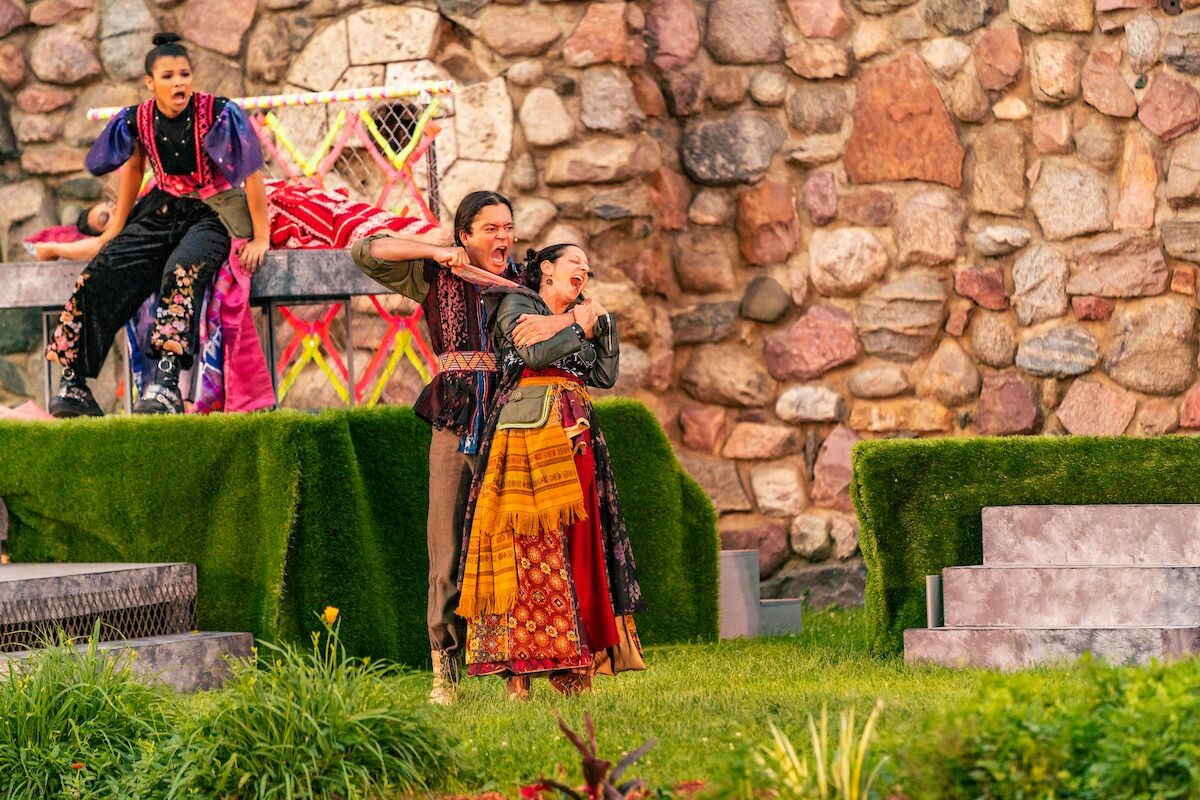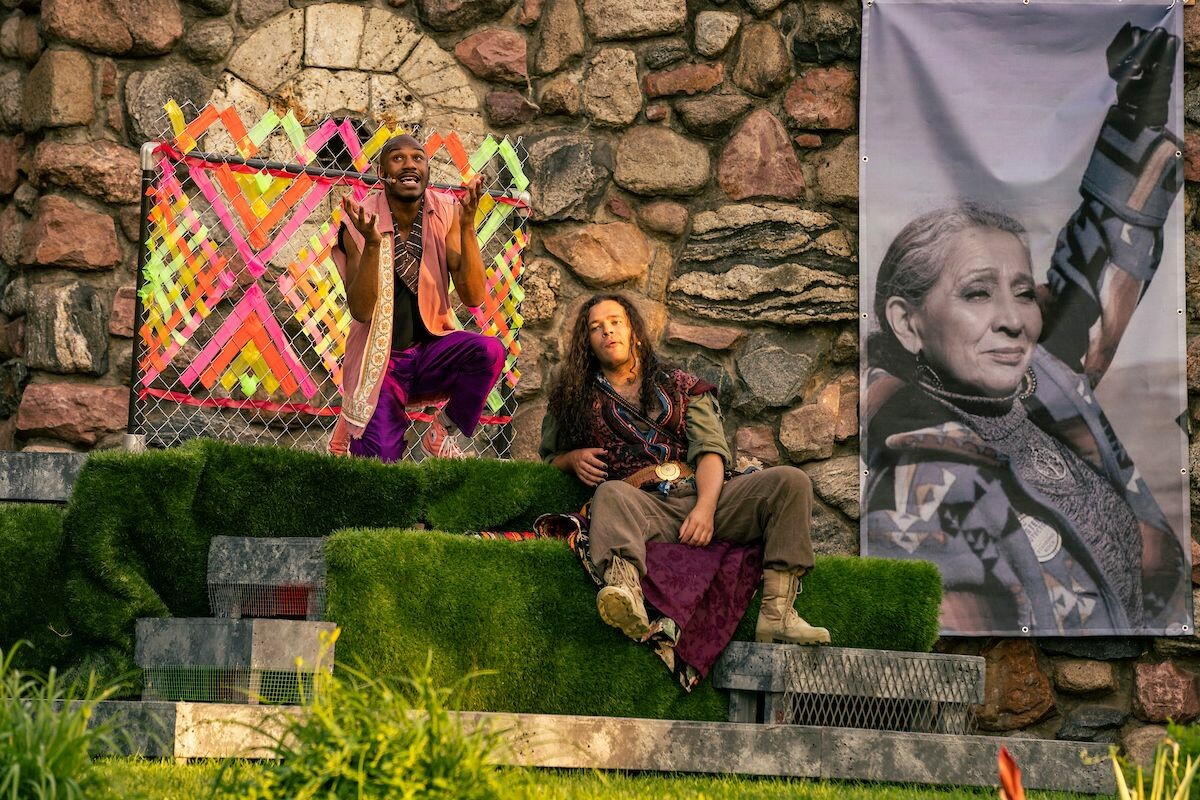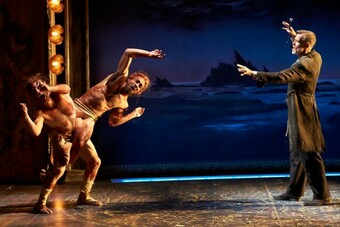“This show may make you angry,” warned director/adaptor Tara Moses, an accomplished theatre artist and citizen of the Seminole Nation of Oklahoma. Lounging on lawn chairs and blankets on the inviting green space of Prentice Park in Vermillion, South Dakota, the predominately white audience at the opening night of South Dakota Shakespeare Festival’s (SDSF) production of William Shakespeare’s Othello listened to Moses’ passionate pre-show speech. After graciously greeting us in Mvskoke, her native language, and playfully advising that it was “okay to laugh at the funny parts,” Moses counseled, “You might feel unsettled… decolonization is difficult and unsettling work.”
Moments later, the diverse cast of Othello erupted into a joyous celebration after a character called Chief Ven (Marquise Howard) proudly delivered the following address:
611 years ago, they first invaded.
557 years ago, they stole, displaced, and enslaved millions of Indigenous people from Africa. 157 years after that, they celebrated the birth of their illegal nation.
For 400 years, they reviled in the genocide and enslavement of your and my peoples.
Yesterday was their last day of celebration.
Moses’ respectful pre-show warning proved prophetic, at least for the white, middle-aged women sitting directly behind me. After the cheering quelled onstage, I overheard her mutter, “Did he just say that our country is illegal?”
In her bold adaption of Othello, Moses definitively answers, “Yes.” Her Indigenous Futurism vision of Shakespeare’s play about race and revenge took place in the year 2176 in “fully restored Indian Territory” immediately after the final battle in the “War of Restoration.” As we soon surmise, Native American revolutionaries successfully disestablished the United States by uniting with Black Liberation forces. Together, they fully restored tribal sovereignty of the land.
Before the show even began, multiple elements pointed the audience toward Moses’ forward-thinking production concept. Those of who arrived an hour early to the opening night performance witnessed a delightful performance from the Eagle Voice Singers, a local Native drum group, on the lawn directly in front of Prentis Park’s grass stage. As the audience claimed our spots on the green, we took in Jill Clark’s evocative scene design, which was dominated by three photographs of social-change warriors printed on large poster boards. On stage-right sat Ella Deloria; an iconic image of Malcom X rested centerstage; the most historically recent of the photographs, an image of LeDonna Brave Bull, watched over stage-left. Although Prentis Park’s stone wall and large downstage flowerbed limits the flexibility for scene design, Clark included small backdrops of chain-link fence woven through with ribbons of neon pink, orange, and green designs inspired by Lakota patterns. As made evident through Clark’s scene design, “The War of Restoration” restored an Indigenous visual identity to the Great Plains landscape.
But the most vibrant design element of SDSF’s Othello appeared once the show began. Elizabeth Wislar, a member Northern Cherokee Nation, crafted stunningly colorful and multi-layered costumes. While the flowing lines of her beautiful creations (Wislar uses the term “costume creator”) suggested a Renaissance vibe appropriate for Shakespeare in the Park, her radiant use of color and intricate prints succeeded in creating an entirely original Native-inspired yet multicultural world. If awards were given for individual designs, Wislar deserves them for her regal robe for Chief Ven and her elegant design for Montano (Lucia Graff), replete with deep purple balloon sleeves, a kimono-like waistband, and flowing black Renaissance skirt playfully underscored by black leggings. Although I appreciated the attempt to reduce the hyper-masculine warrior connotations of the title character of Othello (Cody Floyd), his pink Converse high-tops, bright purple pantaloons, and bowling-shirt inspired pink vest evoked a comic/clowning presence that, at least for me, diminished the tragic gravitas needed for his later scenes. Overall, however, Wislar’s creations served the play with dazzling brilliance and ingenuity.
Achieved through Native rather than European justice, the punishment rippled with the weight of irrevocable loss.
Beyond the designs, Moses utilized an Indigenous lens for several innovative production choices. Three choices stood out: Moses infused Shakespeare’s text with Native American references and perspectives; emboldened and strengthened the women characters; and refused to allow the scripted violence within Shakespeare’s blood-soaked revenge tragedy to further infect her dreamed-for future.
SDSF’s Native American take on Othello impacted both the language and storytelling. With multiple tribes represented in the cast, each Native actor added phrases from their own languages throughout the script. Moreover, Moses significantly modified Shakespeare’s plot. Iago (Chingwe Padraig Sullivan), the instigator of so much turmoil and death, remained alive at the end of the play—a twist on the original text, in which Shakespeare leaves his fate a mystery. Significantly, Sullivan a member of the Shinnecock and Montaukett nations. Within these Native American cultures, the sentence of banishment historically represents a devasting and ultimate punishment. In Moses’ adaption, Chief Ven appropriated a line directed at Iago but originally said by Lodivico: “This is thy work. The object poisons sight.” Moses then added the line, “Only the worst fate is true for thee: Banishment from our community.” After learning his fate, Iago made a painfully long exit, walking dozens of yards of green space directly through the audience. Achieved through Native rather than European justice, the punishment rippled with the weight of irrevocable loss.
An even more noticeable alteration to the plot involved changing the fate of another character also played by a Native American actor. In Shakespeare’s text, Iago secretly and ruthlessly slits the throat of his insecure accomplice, Roderigo (Kenny Ramos) rather than allow Roderigo to publicly reveal Iago’s insidious schemes. Romos is from the Barona Band of Mission Indians/Kumeyaay Nation in California. In Moses’ adaptation, Iago silenced his gullible co-conspirator by shoving a strip of fabric into his mouth. Still alive, Roderigo was therefore free to make a final appearance at the end of the play, personally carrying Iago’s incriminating letters onstage and thus assisting in the prosecution of his traitorous former ally.
Thanks to Moses’ strategic textual addition, Iago’s political treachery arose, at least in part, in response to a failure of adequate representation.
Via an email conversation, Moses graciously shared her rationale for this script change with me: “During the first read, I realized that at the end of the play all the Native characters were either dead or banished. That is not the message I want to leave audiences with at all.” Moses further clarified that her primary goal of the production was “to highlight the important connection between Black Liberation and Tribal Sovereignty and how, in order to achieve both, we must also achieve a deep solidarity with one another.” She kept Roderigo alive to keep her goal from being lost at the end of the show. His redemptive presence provided an example of a Native character who initially mirrored then overcame the learned aggression of his colonialist oppressors.
Moses’ Indigenous lens enhanced the characterization of Iago as well. While the acting was excellent throughout the production, Sullivan’s magnetic performance in this villainous role stood out. In addition to deftly mastering the complicated language with fluidity and clarity, Sullivan, exuded an irresistible charisma and likability. Indeed, he crafted the most relatable Iago I have had the pleasure to witness. Part of this likability derived from Moses’ decision to develop more fully the source of Iago’s grudge. Yes, this competent warrior was still passed over for promotion in favor the less experienced Casio. But in this Indigenous Futurist production, the decision to promote a non-Native Casio to leadership carried added weight. Following the independence celebration in Act One, Iago vented to Roderigo with Moses’ added line, “How does this neglect uphold the community we all swore to the Lakota…?” Roderigo, answered, “My confusion lies in that, when the opportunity arose for shared leadership, neither Othello nor Chief Ven considered the slight to not have a Native in a peaceful position.” Thanks to Moses’ strategic textual addition, Iago’s political treachery arose, at least in part, in response to a failure of adequate representation.










Comments
The article is just the start of the conversation—we want to know what you think about this subject, too! HowlRound is a space for knowledge-sharing, and we welcome spirited, thoughtful, and on-topic dialogue. Find our full comments policy here